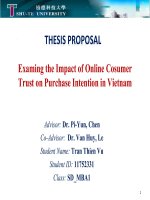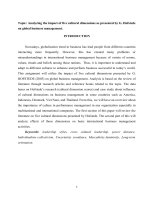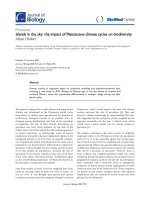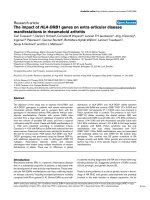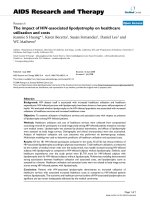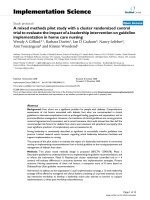Examing the Impact of Online Cosumer Trust on Purchase Intention in Vietnam
Bạn đang xem bản rút gọn của tài liệu. Xem và tải ngay bản đầy đủ của tài liệu tại đây (1.92 MB, 26 trang )
Advisor: Dr. Pi-Yun, Chen
Co-Advisor: Dr. Van Huy, Le
Student Name: Tran Thien Vu
Student ID: 11752331
Class: SD_MBA1
THESIS PROPOSAL
1
Examing the Impact of Online Cosumer
Trust on Purchase Intention in Vietnam
Outlines
2
Research Design
4
1
2
3
Conclusion
5
Abstract (1/1)
Keywords:
3
•
•
•
•
•
•
•
•
•
•
1. Introduction
4
1.
2.
3.
4.
5.
6.
1. Introduction (1/7)
1.1 Research Background and Motivation
5
Ø
•
Overview of Electronic Commerce (EC)
•
Electronic Commerce Evolution in delopped countries
such as United States, Europe, Japa
Ø
Electronic Commerce in Vietnam
•
Infrastructure, Socio-Economics, Socio-Culture,
Government Policy and Regulation
•
Obstacles to e-commerce application in Vietnam
1. Introduction (3/7)
Research Motivation
6
•
and prospose solutions
to
Ø
Personal Perspective:
•
I am a lecturer in department of EC, IT college so I would
like to broaden my horizons in the field of EC
Ø
Propessional Perspective:
1. Introduction (2/7)
7
1.2 Statement of Problem
Ø
Trust is context-dependent and thus its detailed effects may be
related to specific cultural environment. Furthermore, trust, in
general, is an important factor in many social and economic
actions due to its uncertainty and dependency, and a main
issue in E-commerce (Gefen, 2000). However, how important
trust is in the context of Vietnamese B2C E-commerce, and its
impact on purchase intention is a challenging question that is
necessary to investigate empirically. To answer this question is
the first objective of this study
1. Introduction (4/7)
1.3 Research Purpose
8
The intent of this study was to understand the impact
of cognitive-based, affective-based, personality-based,
experience-based factors on the purchase intention
with the mediation of trust in the context of Vietnam
B2C environment. Little or no research is available in
the area of trust, specifically in the e-commerce
industry in Vietnam. The significance and importance
of this study cannot be overstated. Due to different
Vietnamese consumer behaviors from other countries,
the study of trust was founded in foreign market such
as Germany (Sichtmann, 2007), Taiwan (Chen and
Barnes, 2007), India (Ganguly and Dash, 2009),China
(Yaobin and Tao, 2007).Malaysia (Ling et al., 2010).
9
1. Introduction (6/7)
10
1.5 Research Procedure
11
1. Introduction (7/7)
1.6 Terminology
•
•
•
•
•
•
•
•
•
•
2. Literature Review
12
1. Trust and Online Consumer Trust
2. Purchase Intention
3. Information Quality
•
Trust
•
Online Consumer Trust
4. Perceived Privacy Protection
5. Perceived Security Protection
6. The Presence of a Third Party Seal
7. Reputation
8. Familarity
9. Disposition to Trust
Literature review of model of trust
13
Authors Focus area Key findings
Mayer, David, and
Schoorman (1995)
A integrative model of organizational
trust
Bhattacharya, Devinney, and
Pillutla (1998).
A formal model of trust based on
outcomes
Viewing trust as calculative but still psychologically meaningful. The model may be seen as a first step
in integrating psychological approach and economic approach around a very fundamental definition of
trust.
Jarvenpaa, Tractinsky, and
Vitale (2000)
A Model of Consumer Trust in an
Internet-based Store
Perceived size and reputation differently influence consumer’s trust, perception of risk and willingness to
buy.
Lee and Turban (2001) A Trust Model for Consumer Internet
Shopping
Fourth antecedent of consumer trust in Internet shopping was unveiled through a theoretical model
including trustworthiness of the Internet merchant, trustworthiness of the Internet as a shopping medium,
infrastructure factors and other factors, which are moderated by the individual trust propensity.
Kim and Benbasat (2003) A framework for evaluation of trust-
related arguments in internet stores
A framework is based on a model of the customer service life cycle and identifies key trust-related
issues and organizes them into four categories: personal information, product quality and price, customer
service, and store presence.
Cheung and Lee (2004) An Integrative Model of Consumer
Trust in Internet Shopping
Perceived integrity and perceived risk have a strong impact on consumer trust in Internet shopping, while
perceived security control, perceived privacy control, third party recognition, and legal framework have
not significant influence on consumer trust. The relationships between all of independent variables and
consumer trust is significantly moderated by propensity of trust
Sichtmann, 2007 An analysis of antecedents and
consequences of trust in a corporate
brand
Competence and credibility as antecedents of trust and current purchase intention, purchase intention for
product innovation as well as Word – Of – Mouth (WOM) behavior as consequences of trust
Kim, Ferrin, and Rao (2008) A trust-based consumer decision-
making model in electronic commerce
Consumer disposition to trust, reputation, privacy, security, the information quality of website, the
company’s reputation strongly affects on Internet consumers’ trust. Then,
Internet consumers’ trust and perceived risk strongly impact on purchasing decisions
Phung, Yen, and Hsiao
(2011)
Factors associated with consumer’s trust
in the context of B2C e-commerce
Perception about company and website quality influencing on consumer trust and then purchase intention
is examined in both Taiwan and Vietnam
Dimension of Trust
14
Author Antecedents
Doney and Cannon, 1997 Reputation, size, willingness to customize.
Jarvenpaa et al., 2000 Perceive size, perceive reputation.
Cheung and Lee, 2000 Perceived risk, perceived security control, perceived privacy control, perceived
integrity, perceived competence, third party recognition, legal framework.
Lee and Turban, 2000 Ability, integrity, benevolence, technical competence, reliability, medium
understanding, effectiveness of third party certification, effectiveness of security
infrastructure.
Kim et al., 2004 Information quality, perceived privacy protection, perceived security protection,
presence of a third party, positive reputation, familiarity, consumer dispotion to trust.
Gefen and Straub, 2004 Social presence.
Harris and Goode, 2004 Service quality and perceived value
Sichtmann, 2007 Competence and ability.
Urban et al., 2009 Privacy security, site design, user heterogeneity.
Kim, Jin, and Swinney, 2009 e-tail quality
Hsiao et al., 2010 Perceived web reputation, perceived web quality, perceived institution assurance.
(Trust in a website)
Hsiao and Phung, 2011 Perceived size, perceived reputation, system quality, information quality, and service
quality.
Sadeh, Mousavi, Garkaz, Sadeh,
2011
e-service quality
2. Literature Review
15
6. Antecedents of Trust
7. Consequences of Trust
•
Relationship between Trust and Purchase Intention
3. Research Design
A theoretical framework
Hypothesis (1/1)
H1: An online consumer’s trust positively affects the consumer’s intention
purchase.
H2: A consumer’s perceived information quality positively affects the
consumer’s trust.
H3: A consumer’s perceived privacy protection positively affects the
consumer’s trust.
H4: A perceived security protection positively affects the consumer’s trust.
H5: The presence of a Third Party Seal positively affects the consumer’s
trust.
H6: A perceived reputation positively affects the consumer’s trust.
H7: A familiarity positively affects the consumer’s trust.
H8: A disposition to trust positively affects the consumer’s trust.
17
4. Research Methods (1/2)
18
Questions Methods
What level of research is this? Exploratory research
What type of research is it? Quantitive research method
What exactly are you measuring? Trust, Purchase Intention, WOM
behavior in Vietnam B2C context
What measures will you use and
why?
7-points Likert Scale
How you establish validity and
reliability?
Collect online shopping
customers’ e-mails and send them
questionaires
What is your sample frame? Online Survey with approximately
300 sample sizes
4. Research Methods (2/2)
19
Questions Methods
What will you do limit bias, and
improve response rates?
Collect customers’ data who have ever
purchase online in Vietnam
What instruments will you use? Questionnaires
What type of data will you
collect?
Ratio Scale (1-7 points) for measuring
constructs and Categorical, multi choice
and text to for collecting personal
customers’ data
What you need to do collect data? Google Docs appilcation
What medthod of data analysis
will you use and why?
SPSS 16.0 and AMOS 6.0
Ethical constraints and issues Do NOT design data by ramdon by myself
Reference
Ajzen, L., (1991). The Theory of Planned Behavior, Organizational Behavior and Human. Decision Processes, vol. 50, pp. 179-
211.
Braynov, S. and Sandholm, T. (2002). Contracting with uncertain level of trust. Computational Intelligence, vol. 18 (4).
Chen, Y.H., Barnes, S. (2007). Intial trust and online buyer behavior.Industrial Management & Data Systems, vol. 107 (1).
Clavis Technology (2012). ClaviseCommerce Information Quality Insight. Site: www.gs1us.org/
English, L. (1999). Improving Data Warehouse and Business Information Quality: Methods for Reducing Costs and Increasing
Profits. Willey.
Fleenor, C.P. and Raven, P. (2002). Barriers to Effective E-Business in Developing Countries. International Business & Economics
Research Journal, vol.1(4).
Ganguly, B. and Dash, S.B. (2009). Website Characteristics, Trust and Purchase Intention in online stores: An empirical study in
Indian context. Journal of Information Science and Technology, vol. 6(2).
Gefen, D., and Straub, D.W., (2004). Consumer Trust in B2C E-Commerce and the Importance of Social Presence: Experiments in
E-Products and E-Services. Omega, vol. 32, pp. 407 - 424.
Genesan, S., (1994).Determinants of Long Term Orientation in Buyer - Seller Relationships. Journal of Marketing, vol. 58, pp. 1-
19.
Grabner-Krauter, S., and Kaluscha, E.A., (2003). Empirical Research in Online Trust: A Review and Critical Assesment.
International Journal of Human-Computer Studies, vol. 58(6), pp. 738-816
Humphrey, J., Mansell, R., Pare, D. and Schmitz, H. (2003). The Reality of E-commerce with Developing Countries, London:
Media Studies, LSE, www.gapresearch.org/production/ecommerce.html.
Lam, D., Boymal, J., Martin, B. (2004). Internet diffusion in Vietnam. Technology in Society, vol. 26, pp. 39 - 50.
Lawrence, J. E. and Tar, U. (2010). Barriers to ecommerce in developing countries.Information, Society and Justice, vol. 3 (1).
Ling, K.C., Chai, L.T. and Piew, T.H. (2010). The Effects of Shopping Orientations, Online Trust and Prior Online Purchase
Experience toward Customer's Online Purchase Intention.International Business Research, vol. 3 (3).
20
Reference
Lynch, D. and Lundquist, L. (1996). Digital Money: The New Era of Internet Commerce.
New York, Willey.
McKnight, D.H., Choudhury, V., Kacmar, C., (2002). Developing and Validating Trust
Measures for e-Commerce: An Integrative Typology. Information Systems Research,
vol. 13, no. 3, pp. 334-359.
Metzger, M. (2004). Privacy, Trust, and Disclosure: Exploring Barriers to Electronic
Commerce. Journal of Computer-Mediated Communication, vol.9 (4).
Palvou, P.A., (2003). Consumer Acceptance of Electronic Commerce: Integrating Trust
and Risk with the Technology Acceptance Model. International Journal of Electronic
Commerce, vol. 7, pp. 101 -134
Sichtmann, C. (2007). An Analysis of Antecedents and Consequences of Trust in a
Coporate Brand. European Journal of Marketing, vol.11 (9), p.999-1015.
Urban, G.L, Amyx, C., and Lorenzon, A. (2009). Online Trust: State of the Art, New
Frontiers, and Research Potential. Journal of Interactive Marketing, vol. 23, pp. 179-
190.
Urban, G.L., Sultan, F., and Qualls, W. (2000).Placing Trust at the Center of Your
Internet Stategy. MIT Sloan Management Review, Cambrigde, vol. 42(1), pp.39-48.
Yaobin, L. and Tao, Z. (2007). A Research of Consumer's Initial Trust in Online Stores
in China.Journal of Research and Practice in Information Technology, vol. 39 (3).
21
Appendix
Questionnaires
Instruction for participants:
Participants are recommended to visit an online shopping website in Vietnam for the sake of examining your trust in
online company. You can choose and visit a particular website that you are familiar with, regardless of which kind
of product or service it sells. It can be an online bookstore, computer online store, air travel service site, beauty site,
online retailing store, and so on. After choosing web site, you are required to answer following questions:
Name of the visited website: ……………………………….
Name of product or service you choose: ……………………………….
How oftern do you visit this website?
1 time/month
2-3 times/month
1 time/week
2-3 times/week
More than 4 times/week
Have you ever bought products or services from this website?
Never bought
Sometimes
Usually bought
Then, you are required to search for a particular product or service, gather certain details of that product or service. After
searching activities, you are required to fill-out below questions. To answer those questions, circle with the most
appropriate on the scale provided. Circling a "1" means that you strongly disagree that your trust has that feature, and
circling "5" means that you strongly agree. You may circle any of the numbers in the middle that show how strong
your feelings are. There are no right or wrong answers - all we are interested in a number that truly reflects your
feelings regarding to your trust.
22
Information Quality (Kim et al., 2007)
This website provides correct information about item that I want to buy.
This website provides timely information on the item.
This website provides reliable information.
This website provides sufficient information when I try to make a transaction.
Overall, the information this website provides is of high quality.
Perceived Privacy Protection (Kim et al., 2007)
This website is collecting too much personal information from me.
This web vendor will use my personal information for other purposes without my authorization.
This web vendor will share my personal information with other entities without my authorization.
I am concerned about the privacy of my personal information during a transaction.
This vendor will sell my personal information to others without my permission.
Perceived Security Protection (Kim et al., 2008)
This web vendor implements security measures to protect Internet shoppers
This web vendor usually ensures that transactional information is protected from accidentally being altered or destroyed
during a transmission on the Internet
I feel secure about the electronic payment system of this web vendor
I am willing to use my credit card on this site to make a purchase
I feel safe in making transactions this website
In general, providing credit card information through this site is riskier than providing it over the phone to an offline
vendor
23
Appendix
Third-Party Recognition (Lee and Turban, 2001) (A Trust Model for Consumer Internet
Shopping)
There are many reputable third-party certification bodies for assuring the trustworthiness of
Internet merchants.
I think third-party recognition bodies are doing a good job.
Existing third-party recognition bodies are adequate for the protection of Internet shoppers’
interest.
Online Consumer Trust (Gefen, 2000, Jarvenpaa, 2000)
This site is trustworthy
This website vendor gives the impression that it keeps promises and commitments
I believe that this website vendor has my best interests in mind
Intention to Purchase (Gefen, 2000, Jarvenpaa, 2000)
I am likely to purchase the product(s) on this website
I am likely to recommend this site to my friends
I am likely to make another purchase from this site if I need the products that I will buy
24
Appendix
Demographic
Some requireddemographic characteristics need to be
completed:
Gender: Male Female
Age: 18-20 20-22 22-26
over 26
Experience in Internet surfing:
Under 1 year 1-3 year 3-6 year
Over 6 year
Shopping online:
Never shopped Have shopped
25
